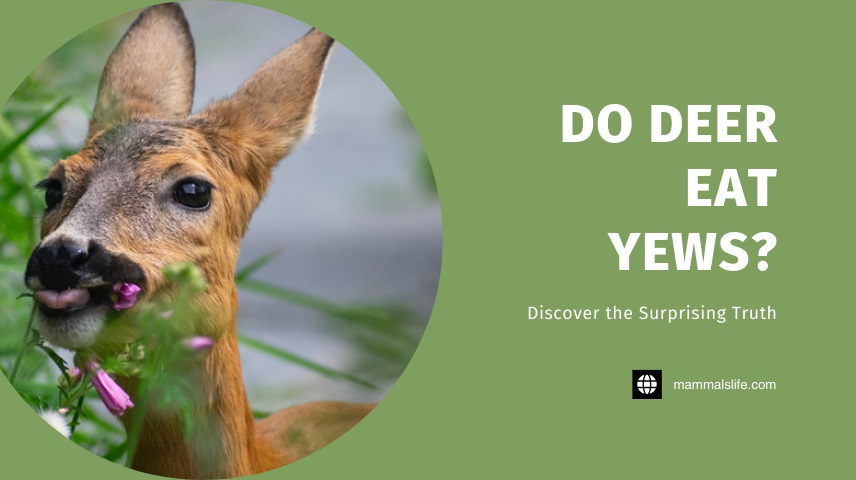Last Updated on February 22, 2025 by Mammals Life
Yes, deer do eat yews. Yews are often targeted by deer, especially in winter.
Deer are known to browse various plants, and yews are no exception. Yews, also known as Taxus, are evergreen shrubs or small trees. They are popular in landscaping due to their dense foliage and attractive appearance. Unfortunately, their appeal isn’t limited to humans; deer find yews quite palatable.
This becomes more pronounced in winter when other food sources are scarce. Deer can cause significant damage to yews, stripping the foliage and sometimes even killing the plant. To protect yews from deer, consider using physical barriers like fencing or applying deer repellents. These measures can help maintain the health and beauty of your yews.
Deer Diet Basics
Understanding what deer eat is essential for managing your garden or landscape. Deer have a varied diet, but they prefer certain foods. Knowing their preferences can help you protect your plants, including yews.
Natural Food Sources
Deer eat a wide range of plants found in the wild. Their diet includes:
- Grasses
- Shrubs
- Leaves
- Fruits
- Nuts
They also nibble on tender shoots and twigs. In forested areas, deer consume tree bark and fallen acorns. This diet provides them with the nutrients they need.
Seasonal Variations
Deer diets change with the seasons. In spring and summer, they eat fresh greenery. During fall, they switch to nuts, fruits, and fallen leaves. In winter, food becomes scarce. Deer then eat bark, twigs, and evergreen plants.
Yews are evergreen shrubs that deer often eat in winter. They provide a vital food source when other plants are dormant.
| Season | Main Food Sources |
|---|---|
| Spring | Fresh leaves, grasses, and shoots |
| Summer | Fruits, nuts, and lush plants |
| Fall | Nuts, fruits, and fallen leaves |
| Winter | Bark, twigs, and evergreens like yews |
Understanding these patterns helps you protect your yew plants. Planting less preferred species can deter deer from your garden.
Yews In The Wild
Yews are fascinating evergreen trees or shrubs found in the wild. These plants are known for their dense foliage and vibrant red berries. They play a crucial role in forest ecosystems. Many wonder if deer consume yews in their natural habitat.
Common Species
Several species of yews thrive in the wild. The most common species include:
- English Yew (Taxus baccata) – Known for its dark green needles.
- Japanese Yew (Taxus cuspidata) – Recognizable by its upright growth habit.
- Pacific Yew (Taxus brevifolia) – Found in North American forests.
These species vary in size and shape, but they share many characteristics. They all produce the iconic red berries and needle-like leaves.
Growth Habitats
Yews are adaptable plants that grow in diverse habitats. They can thrive in both shaded and sunny areas. They prefer well-drained soil but can tolerate a range of soil types.
In the wild, yews often grow in:
- Woodlands
- Hedgerows
- Forest edges
They provide shelter and food for various wildlife. Deer are known to browse on yews, especially during harsh winters. This browsing can impact the health and growth of yew plants.
Yews have a slow growth rate. They can live for hundreds of years. This longevity makes them vital components of their ecosystems.
Deer And Yews Interaction
Deer are known for their browsing habits. This can cause issues for gardeners. One common question is: Do deer eat yews? Let’s explore the interaction between deer and yews.
Browsing Behavior
Deer have specific browsing habits. They prefer certain plants over others. Yews can be part of their diet.
- Deer eat young, tender yew shoots.
- They avoid mature yew leaves and stems.
- Yews contain toxins, but deer often eat them in small amounts.
Understanding deer browsing behavior helps protect your plants. You can use deer repellents or fencing.
Seasonal Impact
Deer eating habits change with the seasons. This impacts their interaction with yews.
| Season | Deer Activity | Impact on Yews |
|---|---|---|
| Spring | Deer seek new growth | High risk to young yew shoots |
| Summer | Deer have more food options | Lower risk to yews |
| Fall | Deer prepare for winter | Increased browsing on yews |
| Winter | Limited food sources | Deer may eat mature yew parts |
Seasonal changes affect deer feeding patterns. Protecting yews year-round is essential.
Potential Risks To Deer
Deer often graze on various plants, but not all are safe. One such risky plant is the yew. Consuming yews can pose significant health risks to deer. Understanding these risks is crucial for anyone managing deer habitats.
Toxicity Levels
Yews contain toxic compounds known as taxines. These compounds are highly poisonous. Even small amounts can be deadly to deer. The needles, seeds, and bark are all toxic.
| Part of Yew | Toxicity Level |
|---|---|
| Needles | High |
| Seeds | Moderate |
| Bark | Low to Moderate |
Symptoms Of Poisoning
Poisoning symptoms can appear quickly. Deer may show signs within a few hours. Here are some common symptoms:
- Weakness
- Tremors
- Difficulty breathing
- Collapse
In severe cases, poisoning can lead to sudden death. Immediate veterinary care is crucial if symptoms appear.
Protecting Yews From Deer
Deer love to munch on yews, which can damage or even kill the plants. Protecting yews from deer is crucial to maintaining a healthy garden. Various methods can help keep deer away from these valuable shrubs.
Fencing Solutions
Fencing is one of the most effective ways to protect yews. A sturdy fence keeps deer out and ensures your yews remain safe. Below are some fencing options:
- Electric Fencing: Electric fences give a mild shock, which deters deer.
- Mesh Fencing: Mesh fences are less visible and can be very effective.
- Wooden Fencing: A tall wooden fence blocks deer physically.
Each type of fence has its pros and cons. Choose one that fits your garden’s style and needs.
Natural Deterrents
Natural deterrents can also help keep deer away from yews. These methods use scents and tastes that deer dislike.
- Plant Deer-Repelling Plants: Plants like lavender and rosemary can repel deer.
- Use Deer Repellent Sprays: These sprays make yews taste bad to deer.
- Install Motion-Activated Sprinklers: These sprinklers scare deer away with sudden bursts of water.
Combining natural deterrents with fencing can provide excellent protection for your yews.
Alternative Plants For Deer-prone Areas
Finding alternative plants for deer-prone areas can be challenging. Deer often feast on gardens, making plant selection crucial. Luckily, several deer-resistant species can keep your garden safe. Below are some great options and planting strategies to consider.
Deer-resistant Species
Deer tend to avoid certain plants. These deer-resistant species can thrive in your garden:
- Lavender: Deer dislike its strong scent.
- Boxwood: This shrub has a bitter taste.
- Marigolds: Their pungent smell deters deer.
- Russian Sage: Its texture and aroma keep deer away.
Planting Strategies
Consider these strategies to protect your garden from deer:
- Fencing: Install a tall fence around your garden.
- Companion Planting: Plant deer-resistant species around vulnerable plants.
- Netting: Use netting over plants during peak feeding times.
| Plant | Deer Resistance Level | Best Season |
|---|---|---|
| Lavender | High | Summer |
| Boxwood | Medium | Year-Round |
| Marigolds | High | Spring |
| Russian Sage | High | Summer |
Frequently Asked Questions
Do Deer Eat Yew Trees?
Yes, deer do eat yew trees. They find the foliage and berries attractive.
Are Yews Toxic To Deer?
Yews are toxic to deer. Eating yews can be harmful and sometimes fatal to them.
How To Protect Yews From Deer?
Use deer repellents or fencing around yews. This can help protect them from being eaten.
Do Deer Prefer Yews Over Other Plants?
Deer often prefer yews over other plants due to their appealing foliage and berries.
Conclusion
Deer can indeed eat yews, posing a risk to your garden. It’s crucial to protect these plants. Using deterrents and fencing can help keep deer away. Consider alternative deer-resistant plants for a safer landscape. Your garden can thrive without falling victim to hungry deer.








